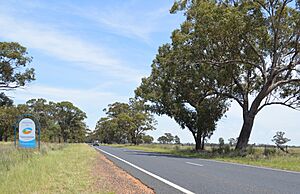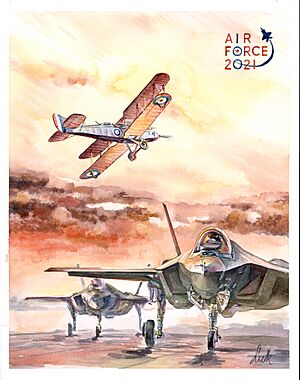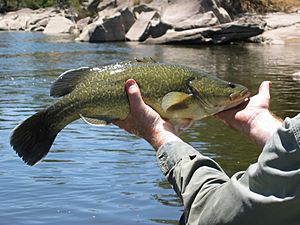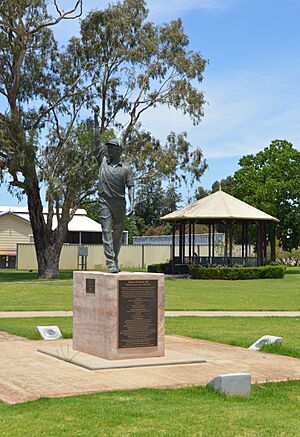Narromine facts for kids
Quick facts for kids NarromineNew South Wales |
|||||||||
|---|---|---|---|---|---|---|---|---|---|
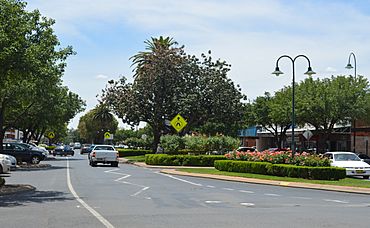
Dandaloo St (Mitchell Highway) in Narromine, 2017.
|
|||||||||
| Population | 3,507 (2021 census) | ||||||||
| Established | 1883 | ||||||||
| Postcode(s) | 2821 | ||||||||
| Elevation | 236 m (774 ft) | ||||||||
| Location | |||||||||
| LGA(s) | Narromine Shire | ||||||||
| State electorate(s) | Dubbo | ||||||||
| Federal Division(s) | Parkes | ||||||||
| Website | Narromine | ||||||||
|
|||||||||
Narromine is a country town in New South Wales, Australia. It's about 40 kilometres (25 miles) west of Dubbo in a region called Orana. Narromine is the main town in the Narromine Shire area. In 2021, about 3,507 people lived there.
Narromine has strong links to Australia's military past. During World War II, it was home to a special fuel depot for planes. It also helped train pilots as part of the Empire Air Training Scheme.
The town is on the traditional land of the Wiradjuri people, one of the biggest Indigenous groups in central New South Wales. The Macquarie River flows right through Narromine. This river is also known by its traditional name, Wambuul, which means 'winding river' in the Wiradjuri language. Both names are now officially recognised.
Narromine is in the Murray-Darling Basin, a big area known for farming. Farmers here grow crops like cotton, beans, wheat, and grain. They also raise animals for wool, lamb, and beef. The Burrendong Dam helps provide water for irrigation, which is very important for farming.
Narromine is also a fun place to visit! You can explore the Narromine Aviation Museum, check out the Aero Club, or enjoy the Mungery Picnic Races. The town also has popular rugby teams, the Narromine Jets and the Narromine Gorillas.
Contents
Narromine's Past
The name Narromine comes from a local Indigenous word. It's from the Wiradjuri word 'ngarru-mayiny', which means 'honey people'. The land was part of Wangaibon territory.
The first European explorer to visit this area was John Oxley in 1818. He followed the Macquarie River. The railway line reached Narromine in 1882, which helped the town grow. The town was officially started in 1883. The first buildings were actually the railway platforms! The Narromine Post Office opened in 1882. Over time, more buildings like a police station and hotels were built.
Early Settlers and Land
After John Oxley's visit, other explorers like Robert Dixon and Major Mitchell also explored the area. In the 1840s, people began to settle on the land. At first, this land was called "Crown land," meaning it belonged to the monarch. However, many settlers, known as squatters, started to use large areas of this land. William Charles Wentworth was one of the first people to own land formally named "Narramine."
Narromine in Poems
Narromine is even mentioned in a famous poem! The writer Banjo Paterson wrote "The City of Dreadful Thirst" in 1889. The poem talks about Narromine nine times. It uses humour to describe the people, floods, and dusty landscape of the town.
The stranger came from Narromine and made his little joke—
"They say we folks in Narromine are narrow-minded folk.
But all the smartest men down here are puzzled to define
A kind of new phenomenon that came to Narromine.
Military History
During World War II, Narromine played an important role. It was home to a special fuel depot for the RAAF (Royal Australian Air Force). This depot was built in 1942 and helped supply fuel for planes.
Training Pilots for War
Australia helped prepare soldiers for World War II through a program called the Empire Air Training Scheme (EATS). This program aimed to train many aircrew. Narromine was one of twelve places where this training happened. It was known as No.5 Elementary Flying Training School RAAF and started in 1940.
Indigenous History
The Wiradjuri people are the traditional owners of the land around Narromine. They are one of the largest Indigenous groups in central New South Wales. For hundreds of years, Wiradjuri tribes lived by the Wambool/Wambuul River (now also known as the Macquarie River). They were skilled hunters and gatherers.
In December 2021, the New South Wales government officially restored the traditional name "Wambuul" to the Macquarie River. This name means 'winding river' in the Wiradjuri language. Now, both names are recognised and used.
Narromine's Surroundings
The Narromine Shire
The Narromine Shire includes the main town and several smaller towns nearby. Many people live on farms between these towns.
The four main towns close to Narromine are:
- Tomingley (about 37 km South)
- Trangie (about 46 km North-West)
- Burroway (about 34 km North)
- Dandaloo (about 65 km West)
Floods in Narromine
Because Narromine is close to the Macquarie River, parts of the town can flood. In March 1926, Narromine had a very big flood. The river rose to 50 feet (about 15 metres)! Roads, phone lines, and the railway were cut off. Another big flood happened in April 1990, when the river peaked at 15.93 metres (52.3 feet).
Plants of Narromine
The Narromine area is home to many native Australian plants. Some of the well-known species include:
- Grey Box Eucalyptus
- Leopardwood Tree
- False Sandalwood
- Old Man Saltbush
- River Red Gum
- Wilga Shrub
- Weeping Myall
Animals of Narromine
You can find many native Australian animals in the Narromine district. Here are some of them:
- Pied Butcherbird
- Short-beaked Echidna
- Barking Owl
- Black Falcon
- Weebill
- Spiny-cheeked Honeyeater
- Grey-crowned Babbler
- Magpie Goose
- Spotted Harrier
- Eastern Blue-tongue Lizard
- Murray Cod
Farming in Narromine
Narromine is in the Murray-Darling Basin, a key farming area. Farmers here use different methods to grow crops and raise animals. They grow beans, wheat, and grain. They also produce wool, lamb, and beef. Many farms in this region combine growing crops with raising livestock. This way, they can adapt to different weather conditions.
Cotton Farming
Narromine is one of the main places where cotton is grown in central New South Wales. Cotton is a natural fibre that is planted in spring and harvested in autumn. Growing cotton needs a lot of water. Farmers use special irrigation systems to water their crops. The Burrendong Dam, built between 1946 and 1967, helps provide water for these farms. This dam has greatly helped farming in Narromine and the surrounding areas.
Narromine's Economy
Farming is a very important part of Narromine's economy. This includes raising sheep and cattle, and growing cotton and cereals. The town also has large plant nurseries and research centres. These help the national forestry and vegetable industries. In 2014, gold mining also started near Tomingley.
Things to Do in Narromine
Narromine Aviation Museum and Aero Club
Narromine is famous for its long history with flying. The Narromine Aero Club, started in 1929, is one of Australia's oldest flying clubs. Commercial flights from Sydney to Narromine began in 1935.
The Narromine Aviation Museum opened in 2002. It was launched by famous Australian aviator Nancy-Bird Walton. The museum shows many old items, photos, and records about the town's flying history. It also highlights Narromine's role in World War II.
The museum has three special aircraft:
- A working copy of the 1907 Wright Flyer Model A
- An original Corben Super Ace homebuilt plane from 1938
- An original Hawkridge Venture glider from 1953
Narromine Gliding Club
The Narromine Gliding Club is a popular spot for glider pilots. It often hosts big gliding competitions for state, national, and even international pilots. In 2015 and 2023, Narromine hosted the FAI Junior and Senior World Gliding Championships.
Mungery Picnic Races
Every year, the Mungery Picnic horse races are held just outside Narromine. It's a traditional Australian country race event. People enjoy "fashion in the field" competitions, where they dress up. There are also race auctions, betting, and fun activities for kids.
Population of Narromine
| Historical population | ||
|---|---|---|
| Year | Pop. | ±% |
| 1921 | 1,399 | — |
| 1933 | 1,617 | +15.6% |
| 1947 | 1,816 | +12.3% |
| 1954 | 1,975 | +8.8% |
| 1961 | 2,282 | +15.5% |
| 1966 | 2,466 | +8.1% |
| 1971 | 2,727 | +10.6% |
| 1976 | 2,802 | +2.8% |
| 1981 | 2,994 | +6.9% |
| 1986 | 3,205 | +7.0% |
| 1991 | 3,378 | +5.4% |
| 1996 | 3,486 | +3.2% |
| 2001 | 3,548 | +1.8% |
| 2006 | 3,599 | +1.4% |
| 2011 | 3,789 | +5.3% |
| 2016 | 3,528 | −6.9% |
| 2021 | 3,507 | −0.6% |
| Source: Australian Bureau of Statistics data. | ||
The 2021 census showed that 3,507 people lived in Narromine.
- About 24.9% of the population were Aboriginal and Torres Strait Islander people.
- Most people (80.3%) were born in Australia.
- About 83.7% of people spoke only English at home.
Famous People from Narromine
Narromine has produced some famous people! These include sports stars like Glenn McGrath (a fast bowler for the Australian cricket team) and Melinda Gainsford-Taylor (a sprinter who won medals at the Commonwealth Games).
Disney animator Adam Phillips and North Queensland Cowboys rugby league player Justin Smith are also from Narromine. Other notable sportsmen include David Gillespie (Australian Rugby League) and David Jansen (International Gliding).
There's even a statue of Glenn McGrath in Tom Perry Park, put there in 2009.
Sports Teams
Narromine has strong local sports teams that compete in regional competitions.
In Rugby League, the town is represented by the Narromine Jets. They play in the Group 11 Country Rugby League competition. The Jets have been very successful, especially their Under 18s team in 2002 and 2003.
Rugby League team:
The town also has a successful Rugby Union team called the Narromine Gorillas. They were started in 1982. The Gorillas won the Graincorp Cup (north) in 2017 without losing a single game! They also won the Blowes Cup in 2009. The Gorillas have junior rugby programs for younger players too.



